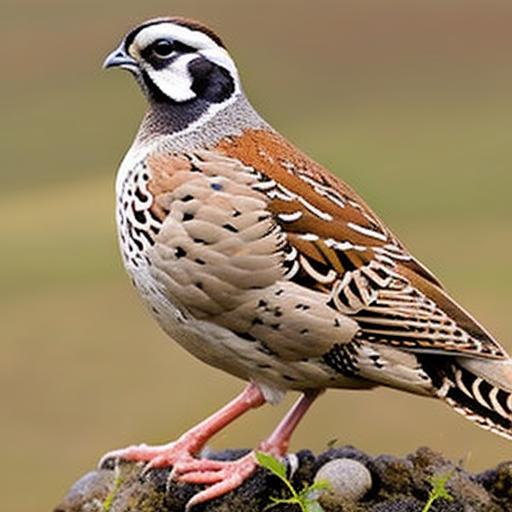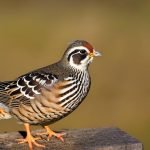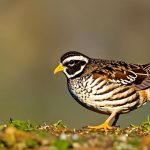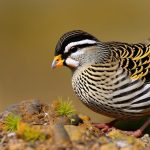Quail keeping on wire has become a popular method for raising quail due to its many benefits. Wire enclosures provide a safe and secure environment for quail, protecting them from predators and allowing for easy cleaning and maintenance. Additionally, wire flooring allows for better air circulation and prevents the accumulation of waste, reducing the risk of disease and promoting overall bird health. Quail keeping on wire is also space-efficient, making it ideal for both small-scale and commercial quail farming operations.
When it comes to quail keeping on wire, choosing the right wire for the enclosure is crucial. The wire should be strong and durable enough to withstand the weight of the quail and any potential predators. Additionally, the wire should have small enough gaps to prevent quail from escaping while still allowing for proper air circulation and waste drainage. There are various types of wire mesh available, including galvanized wire, PVC-coated wire, and stainless steel wire, each with its own advantages and considerations. Selecting the appropriate wire for the quail enclosure is essential for ensuring the safety and well-being of the birds.
Key Takeaways
- Quail keeping on wire is a popular and efficient method for housing quail.
- Choosing the right wire for quail housing is crucial for the health and safety of the birds.
- Designing and building a wire quail enclosure requires attention to detail and consideration of the birds’ needs.
- Maintaining a clean and safe environment is essential for the well-being of quail kept on wire.
- Feeding and watering quail in a wire enclosure requires specific considerations to ensure the birds’ health and nutrition.
Choosing the Right Wire for Quail Housing
When it comes to choosing the right wire for quail housing, there are several factors to consider. The first consideration is the gauge of the wire, which refers to its thickness. A thicker gauge wire is generally stronger and more durable, making it suitable for larger quail breeds or areas with potential predator threats. However, a thicker gauge wire may also be heavier and more expensive. On the other hand, a thinner gauge wire may be more cost-effective and lightweight, but it may not be as sturdy or long-lasting.
Another important factor to consider is the spacing of the wire mesh. The spacing between the wires should be small enough to prevent quail from escaping while still allowing for proper air circulation and waste drainage. A spacing of 1/2 inch to 1 inch is typically recommended for quail enclosures. Additionally, the material of the wire is an important consideration. Galvanized wire is a popular choice for its corrosion resistance and affordability, while PVC-coated wire provides added protection against rust and corrosion. Stainless steel wire is another option known for its durability and resistance to corrosion.
In addition to these factors, it’s important to consider the overall design and construction of the wire enclosure. The wire should be securely fastened to a sturdy frame to prevent sagging or collapsing, and any sharp edges or protruding wires should be covered or eliminated to prevent injury to the quail. By carefully considering these factors, quail keepers can select the right wire for their quail housing to ensure the safety and well-being of their birds.
Designing and Building a Wire Quail Enclosure
Designing and building a wire quail enclosure requires careful planning and consideration of the birds’ needs and safety. The size of the enclosure will depend on the number of quail being housed and whether they are being raised for eggs, meat, or breeding purposes. A general rule of thumb is to provide at least 1 square foot of space per quail to allow for adequate movement and prevent overcrowding. The height of the enclosure should also be tall enough to allow quail to fly short distances, as they are ground-dwelling birds that can become stressed in low-ceilinged environments.
The construction of the wire enclosure should prioritize safety and security. The wire mesh should be securely fastened to a sturdy frame to prevent predators from gaining access and to withstand the weight of the quail. Additionally, the bottom of the enclosure should be reinforced with a solid material such as wood or concrete to prevent digging predators from burrowing into the enclosure. It’s also important to consider protection from the elements, such as providing a roof or cover to shield the quail from extreme weather conditions.
In addition to these considerations, providing enrichment and amenities within the enclosure is essential for promoting the well-being of the quail. This can include perches, shelters, dust baths, and areas for foraging. By designing and building a wire quail enclosure with these factors in mind, quail keepers can create a safe, comfortable, and enriching environment for their birds.
Maintaining a Clean and Safe Environment for Quail on Wire
Maintaining a clean and safe environment is essential for the health and well-being of quail kept on wire. Regular cleaning and sanitation of the enclosure are necessary to prevent the buildup of waste and reduce the risk of disease. This can include removing soiled bedding, droppings, and uneaten food on a daily basis, as well as regularly disinfecting surfaces and equipment within the enclosure.
In addition to cleaning, it’s important to regularly inspect the wire enclosure for any signs of damage or wear. Any broken or damaged wires should be promptly repaired or replaced to prevent potential escapes or injuries to the quail. It’s also important to regularly check for any potential entry points for predators and take measures to reinforce security as needed.
Providing a safe environment also involves monitoring environmental conditions such as temperature, humidity, and ventilation. Proper ventilation is essential for preventing the buildup of ammonia from quail waste, which can be harmful to their respiratory health. Additionally, providing adequate shade and protection from extreme weather conditions is important for preventing heat stress or cold exposure. By maintaining a clean and safe environment for quail on wire, keepers can ensure the health and well-being of their birds.
Feeding and Watering Quail in a Wire Enclosure
Feeding and watering quail in a wire enclosure requires careful consideration of their dietary needs and access to clean water. Quail require a balanced diet that includes high-quality commercial feed supplemented with grains, seeds, greens, and protein sources such as mealworms or insects. The feed should be provided in feeders that are designed to prevent spillage and contamination, as well as to minimize waste.
In addition to providing feed, it’s important to ensure that quail have access to clean water at all times. Waterers should be securely attached to prevent tipping or contamination with bedding or waste. It’s also important to regularly clean and refill waterers to prevent the growth of harmful bacteria or algae that can affect quail health.
When feeding and watering quail in a wire enclosure, it’s important to consider their natural behavior and preferences. Quail are ground-dwelling birds that prefer to peck at their food from the ground rather than eating from elevated feeders. Providing multiple feeding stations throughout the enclosure can help prevent competition and allow all birds access to feed. Similarly, providing multiple waterers can ensure that all quail have access to clean water without overcrowding at a single source.
By carefully considering these factors and providing a balanced diet and clean water in a wire enclosure, quail keepers can promote the health and productivity of their birds.
Monitoring Quail Health and Behavior in a Wire Environment
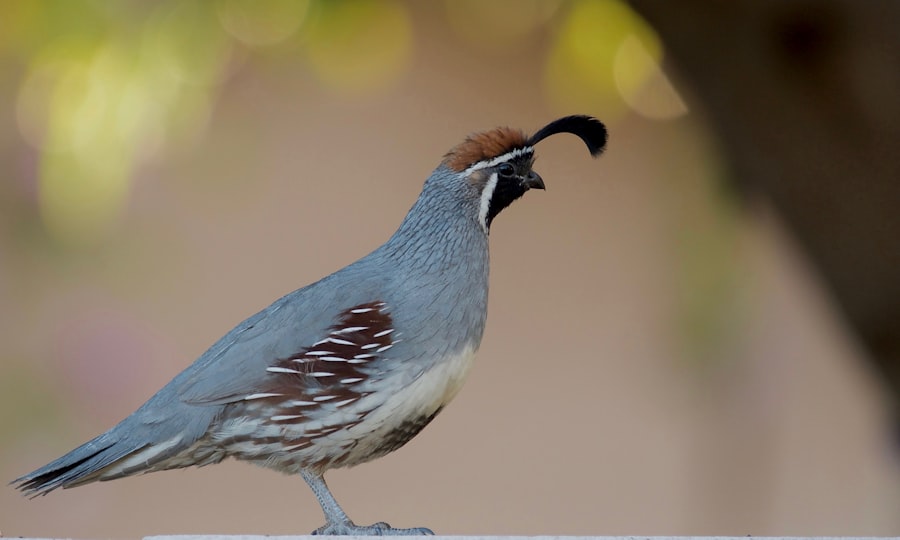
Monitoring quail health and behavior in a wire environment is essential for early detection of any potential issues or illnesses. Regular observation of quail behavior can provide valuable insights into their well-being, such as changes in activity levels, feeding behavior, vocalizations, or social interactions. Any significant changes in behavior should be promptly investigated to identify potential causes or stressors.
In addition to behavioral monitoring, regular health checks are important for identifying any signs of illness or injury in quail. This can include observing their physical condition, such as body weight, feather quality, eye clarity, and overall appearance. It’s also important to monitor their droppings for any changes in color, consistency, or odor that may indicate digestive issues or illness.
In addition to visual monitoring, it’s important to be familiar with common signs of illness in quail, such as lethargy, decreased appetite, respiratory distress, lameness, or abnormal vocalizations. Any signs of illness should be promptly addressed by consulting with a veterinarian experienced in avian health.
By actively monitoring quail health and behavior in a wire environment, keepers can identify potential issues early on and take appropriate measures to maintain the well-being of their birds.
Tips for Successful Quail Keeping on Wire
Successful quail keeping on wire requires attention to detail and proactive management practices. Providing adequate space within the enclosure is essential for preventing overcrowding and reducing stress among the birds. Additionally, providing enrichment such as perches, shelters, dust baths, and areas for foraging can help promote natural behaviors and reduce boredom.
Regular cleaning and maintenance of the wire enclosure are essential for preventing disease and promoting overall bird health. This includes removing soiled bedding, droppings, and uneaten food on a daily basis, as well as regularly disinfecting surfaces and equipment within the enclosure.
Monitoring environmental conditions such as temperature, humidity, ventilation, and protection from extreme weather conditions is important for preventing heat stress or cold exposure among quail kept on wire.
Feeding a balanced diet that includes high-quality commercial feed supplemented with grains, seeds, greens, and protein sources such as mealworms or insects is essential for meeting the dietary needs of quail kept on wire.
Providing access to clean water at all times through securely attached waterers that are regularly cleaned and refilled is important for maintaining hydration and overall bird health.
Regular observation of quail behavior can provide valuable insights into their well-being, such as changes in activity levels, feeding behavior, vocalizations, or social interactions.
Regular health checks are important for identifying any signs of illness or injury in quail kept on wire.
By following these tips for successful quail keeping on wire, keepers can create a safe, comfortable, and enriching environment for their birds while promoting their health and productivity.
In conclusion, quail keeping on wire offers many benefits in terms of safety, cleanliness, space efficiency, and overall bird health. By carefully selecting the right wire for the enclosure, designing and building a secure environment, maintaining cleanliness and safety measures, providing proper feeding and watering practices, monitoring health and behavior regularly, keepers can ensure successful quail keeping on wire while promoting the well-being of their birds.
Looking to expand your poultry knowledge beyond quail? Check out this insightful article on creating the perfect chicken coop by Hannah Montana at PoultryWizard. Whether you’re a beginner or an experienced poultry keeper, Hannah’s tips and tricks will help you create a comfortable and functional space for your feathered friends. Learn more here.
FAQs
What are the benefits of keeping quail on wire?
Quail are kept on wire to provide a clean and hygienic environment for the birds. It also helps to prevent diseases and parasites, and makes cleaning and maintenance easier.
What type of wire is best for keeping quail?
The best type of wire for keeping quail is a strong and durable wire mesh with small gaps to prevent the birds from escaping. Galvanized wire is commonly used for this purpose.
How should the wire be set up for keeping quail?
The wire should be set up in a way that provides a secure and stable flooring for the quail. It should be elevated to allow for easy cleaning and to prevent the birds from coming into contact with their droppings.
What are the considerations for keeping quail on wire?
When keeping quail on wire, it is important to provide adequate space for the birds to move around and exercise. The wire flooring should also be comfortable for the birds to walk on and should not cause injury to their feet.
Are there any drawbacks to keeping quail on wire?
One potential drawback of keeping quail on wire is the risk of foot injuries, as the wire flooring can be hard on the birds’ feet. To mitigate this, providing areas with softer flooring or perches for the quail to rest on is recommended.
Meet Walter, the feathered-friend fanatic of Florida! Nestled in the sunshine state, Walter struts through life with his feathered companions, clucking his way to happiness. With a coop that’s fancier than a five-star hotel, he’s the Don Juan of the chicken world. When he’s not teaching his hens to do the cha-cha, you’ll find him in a heated debate with his prized rooster, Sir Clucks-a-Lot. Walter’s poultry passion is no yolk; he’s the sunny-side-up guy you never knew you needed in your flock of friends!

